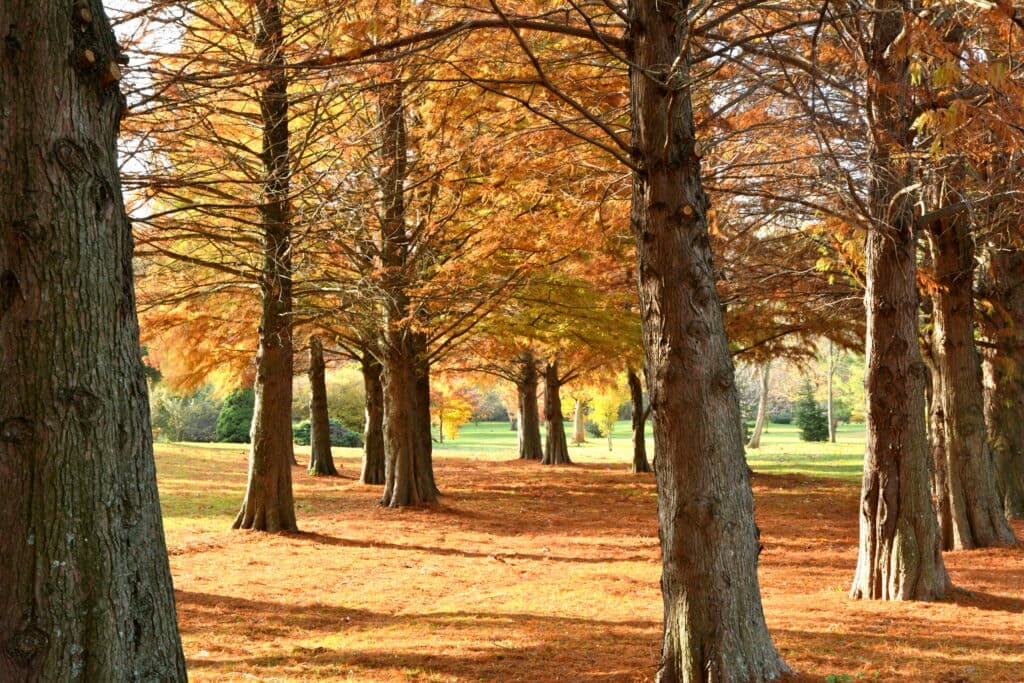Hazard Arboretum
WC's Natural Treasure
Once a cornfield on the edge of the campus, a 13.43-acre plot of land has been an integral part of Wilmington College for more than half a century. The peaceful, beautiful place to visit and working lab for students hosts some 250 wood plants, shrubs and trees.
It was during the presidency of Sam Marble in 1958 when the idea of establishing an arboretum was originally proposed to the College's Board of Trustees, but the death of longtime biology professor Frank O. Hazard (1905-63) in 1963 prompted James Read's administration to jump full force into the project. It was determined the College arboretum would be a "living memorial" to Hazard, a 1927 WC graduate who was known as a "master teacher" during his 34 years on the science faculty from 1928 to 1962.
The professor's studies on the effects of insecticides attracted international interest to the testing laboratory he maintained at the College. He also worked a worm farm as a side business. In 1958, WC conferred an honorary Doctor of Science degree upon Hazard, who also served as dean of personnel and assistant to the president in the 1940s under WC's 11th president, Sheppard Arthur Watson.
The symbolic first planting in the Hazard Arboretum was made at the conclusion of a special program presided over by President Read in October 1963. A tribute in memory of Hazard from Watson was read: "This place is a true memorial to Frank O. Hazard, one of nature's finest sons who, in league with nature's Lord, found creation very good." Those words are contained on the dedication plaque that is affixed to the arboretum's entrance off Elm St. The College held the official arboretum dedication ceremony in 1964.
S. Fredrik Anliot, professor emeritus of biology, was the longtime arboretum curator whose care for the space lasted from his arrival at WC in 1969 through his death in 2012. "Every year, I've tried to put in 20 to 25 new plantings," Anliot said, noting the land was originally a cornfield. "The idea from the beginning was the beautification of the area with unique trees and shrubs. I've often taken my students there to discuss such things as properties of plants and arboretums in general."
Anliot shared the story of how he dealt with the problem of the area's ample number of deer gnawing on the trees. It turned out, the ever-creative professor cut his underwear into strips and tied them to the young trees, an act that apparently repulsed the animals and effectively motivated them to seek food elsewhere.

Some of the more unique species growing in the arboretum include Blue Plume Retinospora, which is native to Japan; Cornelian Cherry, Europe and Asia; Compact Juniper, China; Nootka Cypress, Alaska; Japanese Lilac, Manchuria; Pink Locust, Colorado and New Mexico; and Arrowwood, southeastern United States.
On the 50th anniversary of that first planting in 1963, the College held a ceremony in conjunction with Homecoming which recognized the enduring benefit of Hazard Arboretum to the College and community while also naming the adjacent 19-acres along Lytle Creek as the S. Fredrik Anliot National Area.
Douglas Burks, professor of biology, spoke of Hazard and Anliot and their legacies at WC. "I can think of no two more deserving individuals to recognize today who built the arboretum and biology program." During that ceremony, the College planted a Princeton Elm and Overcut Oak in memory of Hazard and Anliot, respectively.
Donald Troike and Monte Anderson, professors of biology and agriculture, respectively, have no doubt left their footprints of care in the arboretum. In recent years, alumnus Brad Schwamberger '83 has picked up the mantle in continuing the work of maintaining and perpetuating the College's emerald splendor.

Tree Care with Brad Schwamberger '83
Wilmington College Alumnus Brad Schwamberger '83 offers tips and tricks when caring for trees and other plants below.
